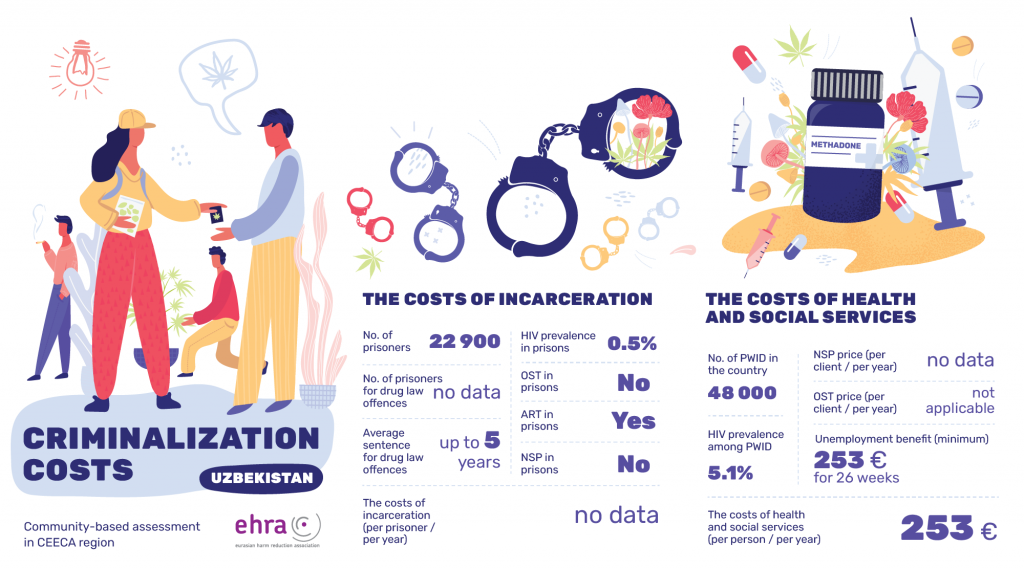There were 22,900 prisoners in Uzbekistan in 2020 [1] but there is no data on how many of them have been incarcerated for drug law offences which can carry a sentence of up to 5 year imprisonment [2]. HIV prevalence among prisoners was estimated in 2018 at 0.5% [3] and antiretroviral therapy (ART) is reportedly available in prisons, but no opioid substitution therapy (OST) or needle/syringe programmes (NSP) exist [4].
There is no data available as to the cost of having one person in prison each year.
As of 2018, there were estimated to be 48,000 people who inject drugs in Uzbekistan, with HIV prevalence estimated through sentinel surveillance in the same year at 5.1% [5].
No data is available as to the cost of NSP and there are no reports of OST services being implemented in the country. Unemployment benefit is paid for not more than 26 weeks (6 months) within a 12 month period and the minimum paid, which is €253 per person covering 26 weeks, or €9.72 per month, is based on the minimum wage of €19.45 per month; a higher amount can be paid based on 50% of the average salary earned in the most recent place of employment but no higher than the average salary prevailing in Uzbekistan at the time when the benefit is calculated [6].
Due to the current lack of data, it is not possible to calculate the approximate cost of supporting one person who injects opioids in community settings in Uzbekistan, nor to compare that cost with expenditures made by the Government to incarcerate that same person in a prison setting.
[1] World Prison Brief. Uzbekistan. London; Institute for Crime & Justice Policy Research, University of London. https://www.prisonstudies.org/country/uzbekistan (accessed 4 August 2021).
[2] Penalties for drug law offences in East Europe and Central Asia at a glance: https://old.harmreductioneurasia.org/drug-laws/
[3] Joint United Nations Programme on HIV and AIDS (UNAIDS). The Key Populations Atlas. Geneva; UNAIDS. https://kpatlas.unaids.org/dashboard (accessed 3 August 2021).
[4] Harm Reduction International (HRI). Global State of Harm Reduction 2020, Regional Overview 2.2 Eurasia. London; HRI, 2021. https://www.hri.global/files/2020/10/26/Global_State_HRI_2020_2_2_Eurasia_FA_WEB.pdf (accessed 3 August 2021).
[5] Joint United Nations Programme on HIV and AIDS (UNAIDS). Country factsheets, Uzbekistan. Geneva; UNAIDS, 2020. https://www.unaids.org/en/regionscountries/countries/albania (accessed 11 August 2021).
[6] Information provided by national partner.

